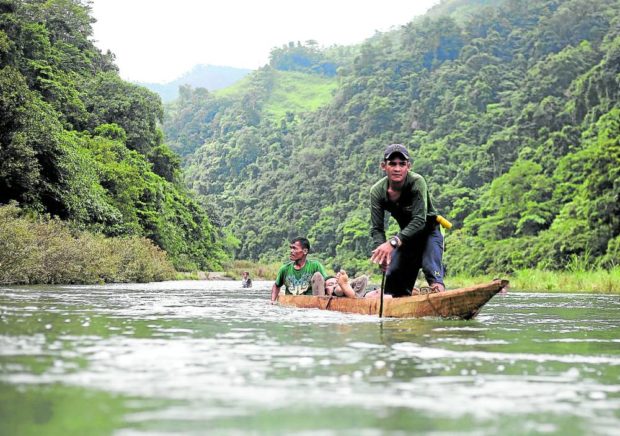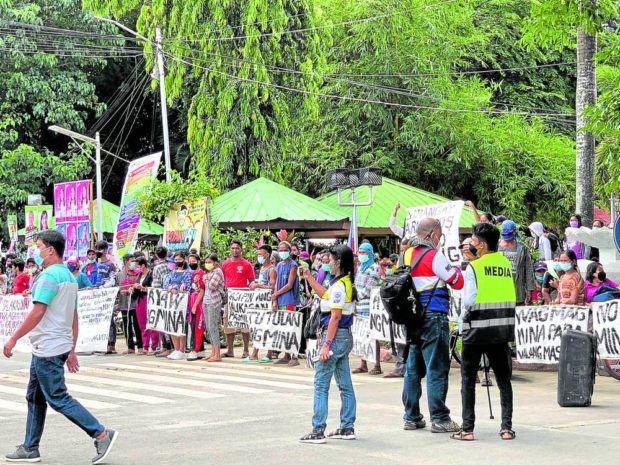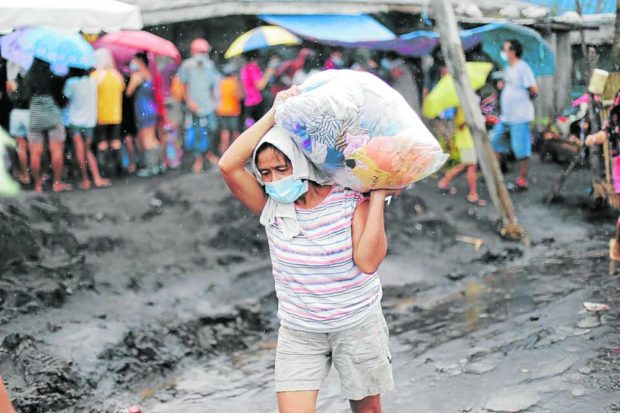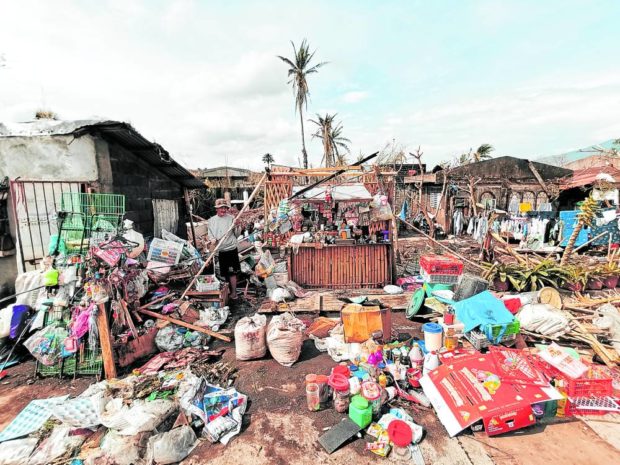Power, environment woes face Southern Luzon bets

HOME OF THE TRIBE A group of Dumagat crosses the Kaliwa-Agos River in Infanta, Quezon province, in a photo taken in August 2019. Indigenous peoples in the Sierra Madre mountains are opposing the construction of Kaliwa Dam in their midst. —RICHARD A. REYES
(Third of a series)
Unstable power supply and big-ticket projects that would lead to the displacement of indigenous peoples (IP) from their ancestral domain and damage to the environment are among the major issues confronting candidates in Southern Luzon in this year’s elections.
The state of the Sierra Madre mountain ranges, hosting the largest remaining patch of old-growth tropical rainforest in the Philippines, will take center stage as conflicting interests of local and national leaders and IP groups clash.
Spanning Luzon’s northeastern coast from Cagayan province in the north to Quezon province in the south, Sierra Madre does not only protect a large part of Luzon by serving as a buffer against typhoons that develop in the Pacific Ocean, it also accounts for 40 percent of the country’s forest cover. Yet, it remains heavily under threat of illegal logging, mining activities, and road construction and development, according to Forest Foundation Philippines.
Nilo Tamoria, regional director of the Department of Environment and Natural Resources (DENR) in Calabarzon (Cavite, Laguna, Batangas, Rizal and Quezon), challenged candidates to take a stand against the destruction of not just the Sierra Madre, but of the country’s forests and natural resources.
Article continues after this advertisementThe latest Global Forest Resources Assessment report of the UN Food and Agriculture Organization showed that the Philippines is left with 7,014,156 hectares of forest cover, or 23.4 percent of the country’s total area of 30 million ha, based on the land cover data in 2015.
Article continues after this advertisementThe need for candidates to protect forests and other natural resources is urgent, Tamoria said, noting that in Quezon alone, 20 illegal logging hot spots within Real, Infanta, and General Nakar towns had been identified.
Kaliwa Dam
Oscar Bernardo Catilo, an environmentalist active in protection efforts for the Sierra Madre in Infanta town, urged all candidates to review the P12.2-billion Kaliwa Dam project in northern Quezon, which covers sections of the Sierra Madre.
The Metropolitan Waterworks and Sewerage System has been pushing for the construction of Kaliwa Dam as a major component of its New Centennial Water Source Project to address a projected water crisis in Metro Manila.
But environmental, religious, and activist groups and some officials in Quezon have opposed the project, with Fr. Pete Montallana, chair of Save Sierra Madre Network Alliance (SSMNA), noting that every Filipino would end up paying for the cost of building the dam.
Studies done by SSMNA showed that the project would submerge parts of the Sierra Madre in Tanay, Rizal; and General Nakar and Infanta towns in Quezon. It is expected to flood a watershed area of 9,700 ha and affect 1,465 families.
The project, Catilo said, should be viewed from the perspective of the rights of IP communities protected by the Indigenous Peoples’ Rights Act of 1997 (Republic Act No. 8371), as well as laws aimed at protecting the environment, like Republic Act No. 7586, or the National Integrated Protected Areas System Act of 1992.
Sierra Madre’s IPs have been firm that they would not give their free, prior and informed consent to the project, a requirement under RA 8371.
The Mangyans of Oriental Mindoro also face the same threat of displacement from the land that their ancestors had nurtured, according to Fr. Edwin Gariguez, director of the Diocesan Social Action Center of the Apostolic Vicariate of Calapan.
Fr. Gilbert Talabong, Unisan town parish priest, said the continuous construction of coal-fired power plants in Quezon province was an urgent concern that provincial candidates should address.
“There should be no more new plants. And those already existing should be converted to environment-friendly operation,” Talabong said.
Quezon is already hosting three coal-fired power plants in Mauban and Pagbilao towns. The construction of another plant in Atimonan town is ongoing amid protests from the Diocese of Lucena and environmentalists.

PROTEST | Residents of Brooke’s Point, Palawan province, gather at the municipal hall on April 5 to protest mining activities in the town. —ROD NACIS/CONTRIBUTOR
Last ecological frontier
The island province of Palawan, the country’s last ecological frontier, is also facing environmental problems that candidates seeking local positions must address.
Grizelda Mayo-Anda, executive director of Environmental Legal Assistance Center Inc., a nongovernmental organization based in Puerto Princesa City, stressed the importance of local governance in environmental management, protection and preservation.
Anda, an environmental lawyer for over 30 years, said locals “must remember who the environmental champions were,” citing the need for review of the candidates’ track record as an important aspect in electing leaders.
“On issues of mining, coal and renewable energy, land grabbing—governance should be a big factor for our voters to remember in the coming elections. Do your research, if you want to make it right, who are those supportive of the fight against mining, who are active champions of renewable energy, environmental justice champions who actually worked on land-grabbing issues?” Anda said.
On April 5, more than 1,000 antimining residents of Brooke’s Point, composed of IPs and farmers, staged a protest in front of the town hall.
Pastor Job Lagrada, one of the protest organizers, lamented that the welfare of marginalized communities that their group represents was being overlooked, despite repeated demands to stop mining operations in the town.
In the tourist town of Coron, environmental advocates got a reprieve when President Rodrigo Duterte halted a massive reclamation under the Coron Bay Reclamation and Development Project (CBRDP) spearheaded by the provincial government of Palawan and its joint venture partners.
After meeting with Sagip Coron, a group organized by concerned residents, Duterte on March 22 instructed the DENR and the Philippine Reclamation Authority to issue cease-and-desist orders and the forfeiture of the illegally reclaimed land in favor of the government.
Sagip Coron convener Bob Magallanes said illegal reclamation and quarrying in the town had been causing environmental destruction to its once unspoiled environment.
“Coron is one of the most beautiful and pristine sanctuaries in our country. We must protect it and I will protect it. To quarry and devastate nearby mountains for soil to dump and fill the marine habitats that will also destroy the area’s foreshore land for commerce and profit is an assault on the environment and the long-term future of the area for sustainable, nondestructive, businesses like tourism, fisheries and agriculture for the benefit of the people of Coron and its future generations,” Magallanes said in a statement on April 5.

SEEKING SAFETY | A resident of Camalig, Albay, carries a pack of clothes for her family as they seek shelter in an evacuation center after Typhoon “Rolly” hit Bicol in 2020. —GEORGE GIO BRONDIAL
Power woes
The CBRDP, according to the town’s tourism master plan, is a two-phased 50-ha investment initiative projected to respond to the future demand for land for tourism and commercial activities. It will cover coastal areas in three Coron villages, which has an average depth of 5 to 7 meters from the seafloor.
In the Bicol region, unstable power supply plagues most of its provinces despite having two geothermal fields that power Luzon.
Local power distribution firms and cooperatives in the region are saddled by various operational and technical problems such as unpaid consumer bills, system losses caused by rampant power pilferages, and antiquated transmission lines and stations that are easily damaged by strong typhoons that frequently hit the region.
The island province of Catanduanes suffers unscheduled and frequent power interruptions that the First Catanduanes Electric Cooperative Inc. attributed to old wires damaged by storms or strong winds.
In Masbate, consumers complain of weekly rotational and unannounced brownouts which could stretch to over 12 hours on Saturdays due to insufficient power supply for its growing number of consumers.
Rosemarie Quinto Rey, president of Albay Chamber of Commerce and Industry (ACCI), wondered why consumers in Albay have to pay the high cost of electricity when the province and its neighboring Sorsogon produce geothermal energy.
“Is there any possibility of getting a lower electricity rate here? How about the rampant, scheduled and unannounced brownouts, what are their plans to ease the burden of people from experiencing such?” Rey asked.

DEALING WITH CALAMITY Bicolanos have learned to live with calamities as they deal with the impact of destructive typhoons and the constant threat of volcanic eruption. In this photo taken in October 2020, a resident of Malinao, Albay province, sorts through the debris left by Typhoon “Rolly” (international name: Goni). —GEORGE GIO BRONDIAL.
Disaster preparedness
Added to Bicol’s woes is having to deal with destructive typhoons, the region being located on the country’s eastern seaboard frequented by typhoons, with often very little quick response fund to go around.
For Lemuel Surtida, provincial administrator of Catanduanes, the creation of a Department of Disaster Resilience would benefit the island province.
“With the creation of the department, it would enhance the disaster risk resilience capability [of local governments] in terms of manpower, equipment, and infrastructure,” he said.
He said it would also speed up the response and fill the gap in addressing the needs of the affected considering there would be a budget allotment.
According to ACCI president Rey, the Bicol provinces, despite being prone to disaster, do not have concrete plans to build permanent shelters for people who live in high-risk areas.
—REPORTS FROM DELFIN T. MALLARI JR., MADONNA T. VIROLA, ROMAR MIRANDA, MAR S. ARGUELLES AND MICHAEL JAUCIAN
RELATED STORIES
No haste in Kaliwa Dam consultations – MWSS
NEA urged to take over Bicol power coop due to frequent brownouts